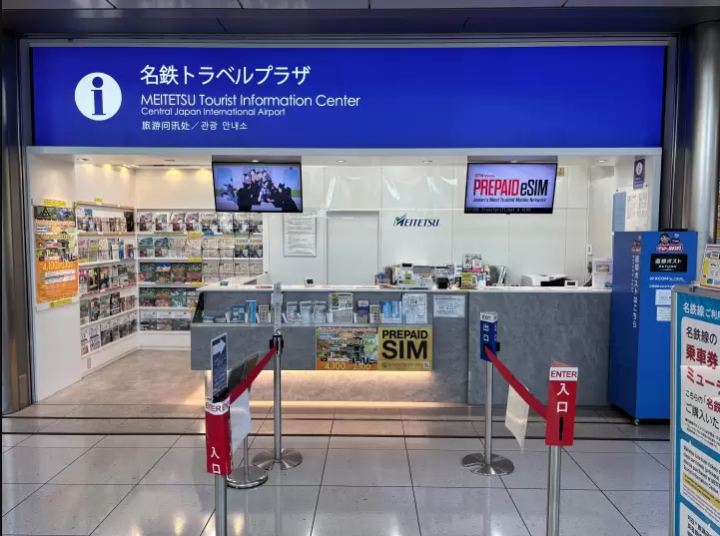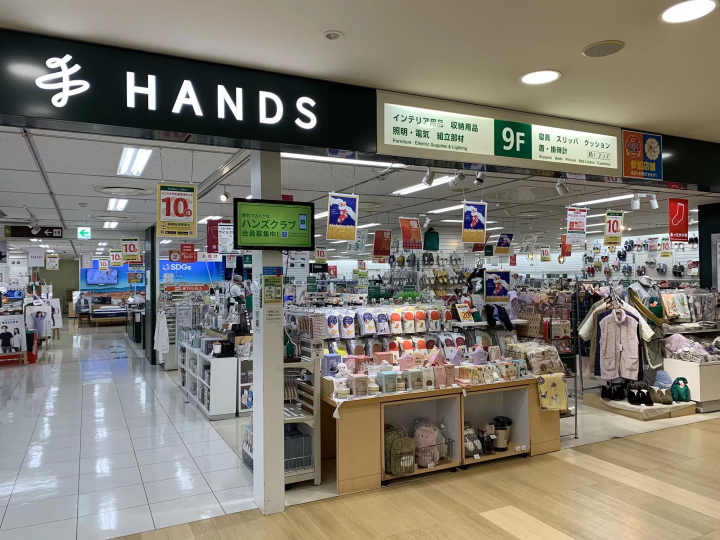[Himeji City] Goso Monaka Honpo, a Japanese confectionery shop that has a history alongside Himeji Castle
![[Himeji City] Goso Monaka Honpo, a Japanese confectionery shop that has a history alongside Himeji Castle](https://resources.matcha-jp.com/resize/720x2000/2023/09/26-147100.webp)
Since the Showa era, Gojo Monaka Honpo has been popular with locals and tourists alike for its Himeji Castle-related sweets. Would you like this as a souvenir from Himeji or as a keepsake for yourself?
-
Table of Contents
- A local confectionery shop
- Let's eat Himeji Castle! The majestic castle in a cute monaka
- That whiteness again! A new type of monaka in collaboration with local high school students
- A heavy, solid stone wall is expressed with soft dorayaki.
- How about adding your own original branding mark to your crispy Kawara Senbei rice crackers?
- Chocolate and rice crackers come together to create a new Himeji specialty
- Cherishing our connections with the local community and adding new appeal
- Access methods
- Great value bus tickets
- basic information
A local confectionery shop

"Goso Monaka Honpo" is the name of the Nakano Co., Ltd., which was founded in 1958. The main store is located in a quiet alley lined with private houses, close to Kyoguchi Station on the JR Bantan Line.
![[Himeji City] Goso Monaka Honpo, a Japanese confectionery shop that has a history alongside Himeji Castle](https://resources.matcha-jp.com/resize/720x2000/2023/09/26-147101.webp)

"It's a place of relaxation where locals can drop in and chat casually," says Mai. On the day of the interview, regulars were dropping in one after the other. Seeing them casually chat with the shop staff and leave with smiles on their faces, I could sense the warmth that can only come from a shop that is deeply rooted in the community.
Let's introduce each of the store's famous sweets, which are made with the desire to "deliver good things made with good ingredients."
Let's eat Himeji Castle! The majestic castle in a cute monaka
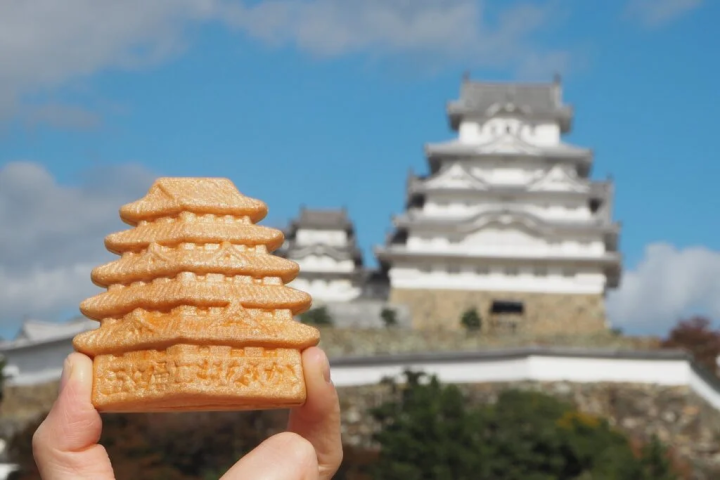
The "Gosou Monaka", which is modeled after the five-story main tower of Himeji Castle, was created by Mai's grandfather, the current chairman, to commemorate the castle's major renovation during the Showa era.
When you open the package, you'll be greeted by the fragrant aroma of the mochi skin. You'll want to take a bite right away, but first take a good look at it. The roof, windows, and other details have been recreated, and it can stand on its own, befitting its status as a World Heritage Site.

The crispy, fragrant skin is hand-baked using Hiyoku glutinous rice from Saga Prefecture, and the bean paste inside is made from Hokkaido-grown red beans, giving it a refined sweetness. The feeling of unity when you put it in your mouth is irresistible. Chopped chestnuts peeking out from inside the bean paste add an accent to the flavor and texture.
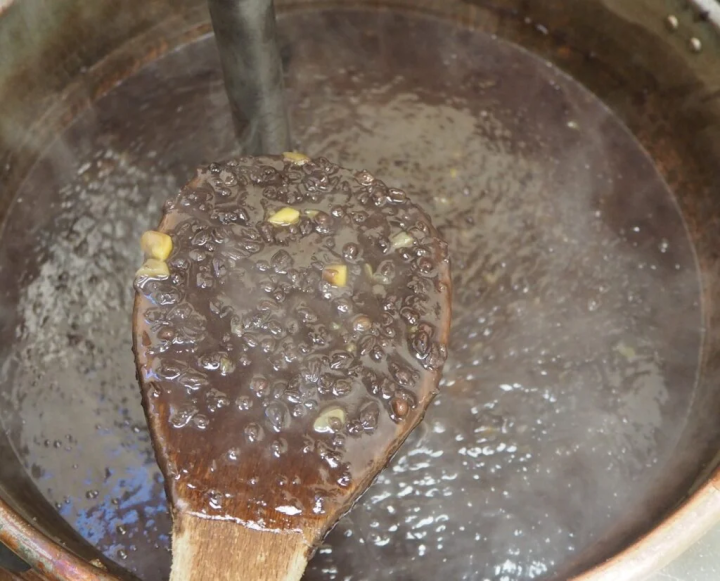

The bean paste is cooked using a unique method especially for monaka. The second-generation president of the company devised a sugar mixture that was "moderately sweet in keeping with the times" and arrived at this flavor.

Break it into a bowl and pour in hot water to make oshiruko. The skin will take on a chewy texture, making it very satisfying to eat. Look at it, smell it, eat it. Enjoy the cute castle with all your senses.
That whiteness again! A new type of monaka in collaboration with local high school students

During the Heisei era's major repairs, this monaka was made. It was named "Castle White Monaka" after the image of a castle that has been repainted white with plaster. It is a collaborative product with Himeji Prefectural Commercial High School, and was completed after repeated prototypes incorporating ideas from students.
Inside the pure white shell is white bean paste mixed with cheese. We've also added white chocolate chips to add texture, in pursuit of the ultimate white flavor. The mellow sweetness and new taste sensation are said to be popular among young people and women.
When it was renovated, Himeji Castle was called "Too White Castle" in a play on its nickname "White Heron Castle." Eight years have passed since then, and it is no longer "too white," but the castle white monaka wafers tell the story of how white it was back then.
Limited time offer from late October to early May. Sakura bean paste will be available during cherry blossom season.
A heavy, solid stone wall is expressed with soft dorayaki.

If the Gosō Monaka is a confectionery modeled after the main tower of a castle, then the Himeji Roman is a Japanese-Western fusion dorayaki that is modeled after a stone wall. The dough, which uses plenty of eggs, is soft and fluffy. The moderately sweet bean paste and cream are in harmony, and the chopped chestnuts also work well here.
Where's the stone wall? If you're wondering that, take a closer look at the dough. You'll see that the browning pattern resembles a stone wall. This browning pattern changes greatly depending on the heat and baking time, so fine adjustments are essential to create the same pattern.
In addition, the filling is made using a different method than that used for monaka in order to match the Western flavor, demonstrating the shop's spirit of inquiry into sweet making.
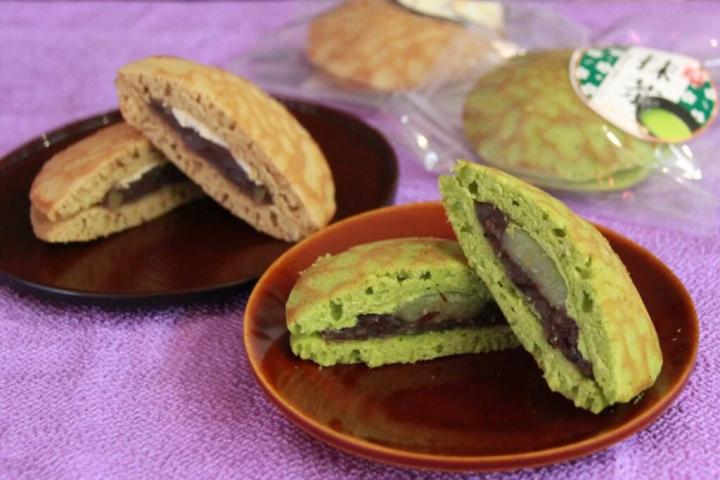
Himeji Roman, which makes the most of the flavor of the ingredients, is also popular. "Matcha" is made by kneading matcha into the dough and cream and sandwiching matcha mochi in between. "Caffe Latte," which uses an original blend of coffee beans, "Himeji Coffee," has an exquisite balance of the bitter coffee and sweet bean paste. There is also a refreshing "Yuzu" flavor made with plenty of yuzu from Yasutomi Town.
Himeji Roman is popular among not only children and women, but also men. I am impressed by the sense of style in expressing the solid stone walls in the dorayaki. Enjoy your meal while immersing yourself in the romance of the castle town with a long history.
We also recommend freezing it and making it into ice cream dorayaki, or baking it in the oven until crispy.
How about adding your own original branding mark to your crispy Kawara Senbei rice crackers?
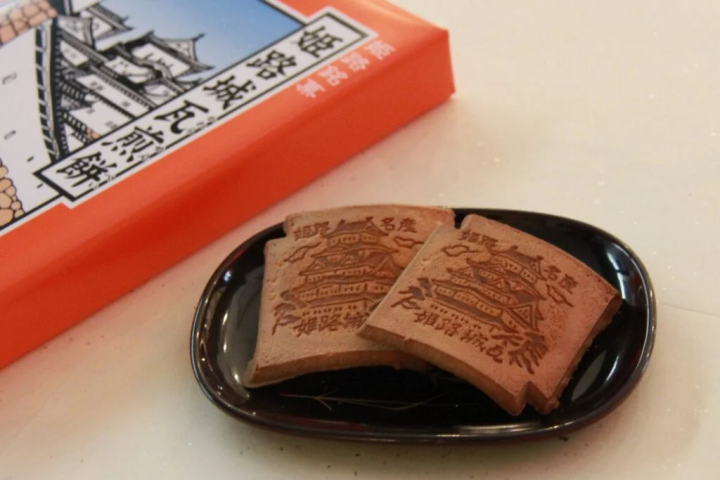
After the main castle tower and stone walls, the last thing is the roof tile. "Himeji Castle Tile Rice Crackers" are slightly sweet egg rice crackers shaped like the tiles of Himeji Castle.
When you think of kawara senbei, you think of something hard, right? Although it's not as hard as a real tile, you still need to be prepared to bite into it, but the kawara senbei at this shop boast a crunchy texture that makes them easy to eat even for the elderly and children. The beautiful Himeji Castle branding, which is hand-stamped on each cracker, adds a nice touch.

You can also have your own original branding on the Kawara Senbei. Many people order these as company commemorative gifts or personal gifts. How about adding a portrait and handing them out as business cards?
Chocolate and rice crackers come together to create a new Himeji specialty
The combination of Kawara Senbei and chocolate has resulted in the creation of a new product: chocolate-covered rice crackers called "Choco-sen." Himeji City has a long-standing partnership with Showa Women's University, and Goso Monaka Honpo has been tasked with commercializing the product in collaboration with the university.
Mai also participated in the development, and three types of Choco-sen were created.

The "Milk Chocolate" is fragrant with sliced almonds and brown rice puffs, while the "White Chocolate" is inspired by Himeji Castle and is topped with colorful chocolates to create a retro atmosphere. The "Strawberry Chocolate" uses strawberry powder from Himeji and features a design of Senhime, who is known as the last heroine of the Sengoku period and lived a turbulent life.
The gorgeous appearance of the strawberry dices and pistachios is a sight to behold, but the rich strawberry aroma and sweet and sour taste are also enchanting. The mellowness of the chocolate and the crispy texture of the rice crackers go perfectly together, making the encounter between the two seem like fate.

The packaging is a vibrant pink color, making it perfect as a souvenir. Mai says, "I hope that Choco Sen will help people get to know our store."
This year marks the 30th anniversary of Himeji Castle being registered as a World Heritage Site. This sweet is sure to become a hot topic, not only as a Himeji specialty but also as a special anniversary treat.
Cherishing our connections with the local community and adding new appeal
It can be said that Goso Monaka Honpo has a history that goes hand in hand with the castle. The sweets that have been loved since they were created have been improved over time to suit the times. And the new sweets that have joined the line-up are sure to be loved for a long time to come.

Mai says she will continue to try her hand at developing collaborative products and products using locally produced ingredients.
"It's amazing that I grew up in a town that has a world heritage site and am able to do this job. I want to get young people involved in creating new products and liven up the area. I think that's the best way I can give back to my hometown," she says, her eyes sparkling. We're looking forward to seeing what kind of charm Mai will add to the traditions built by her grandparents and father.
(While working as a writer)
*This article is current as of March 2023. Prices include tax. Product contents and prices may be subject to change.
Access methods
Take the Shinki Bus No. 21 (to Kashima Shrine) or No. 22 (to Yuhigaoka) from bus stop No. 16 at Himeji Station (North Exit), get off at the Kamiyacho bus stop, and it is a 2-minute walk from there.
Great value bus tickets
Hyogo Amazing Pass
With this ticket, you can ride the local buses (Shinki Bus orange buses) that run in Hyogo Prefecture, and the City Loop and Port Loop that run in the center of Kobe, all for 2,500 yen a day! Himeji Castle, Shoshasan, Taiyo Park, Suhama Shrine, Port Tower, Nankinmachi, Mita Premium Outlets, and more - wherever you go is up to you. You can enjoy a local trip to the fullest.
*Cannot be used on express buses, community buses, Himeji Loop buses, etc.
Luggage storage service
Would you like to go sightseeing empty-handed?
basic information
Nakano Co., Ltd. Gosyo Monaka Honpo
Address: 71 Saiwai-cho, Himeji City
Phone number: 079-284-2525
Business hours: 8:00-17:00 *The products introduced in this article can also be purchased at the Himeji Piole Souvenir Shop in front of JR Himeji Station (8:30-20:00)
Closed: Open all year round
Parking: Available
Official website :
What are good things and good experiences? There are many characteristics such as having a story to tell, overflowing with the thoughts of the creator, having a history, and being loved by the locals. Have you ever come across a special thing or experience that made you want to tell someone about it? And as a result of telling, someone new leads to something. We think that's what "good" is all about. In order to deliver such encounters to our customers, we discover Hyogo's good things based on the concept of "talk, communicate, and connect", and provide information that will shorten the emotional distance between customers and the region of Hyogo Prefecture.
The contents on this page may partially contain automatic translation.


![[Hyogo Prefecture] Unlimited rides on local buses for just 2,500 yen! Travel around Hyogo Prefecture at a great price](https://resources.matcha-jp.com/resize/200x2000/2023/09/25-146913.webp)



















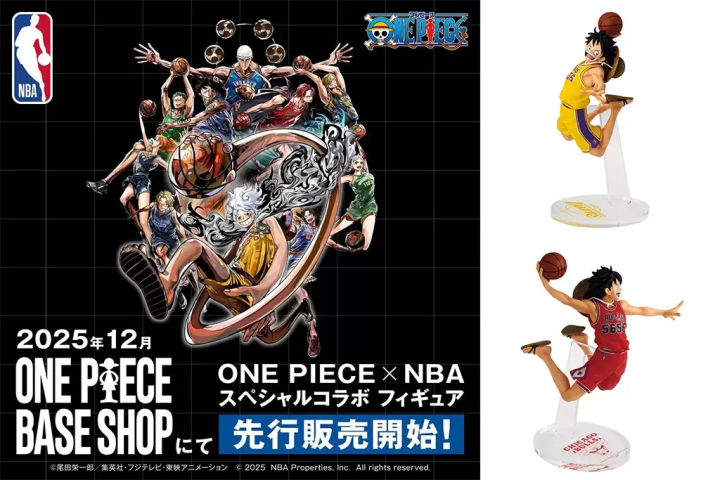

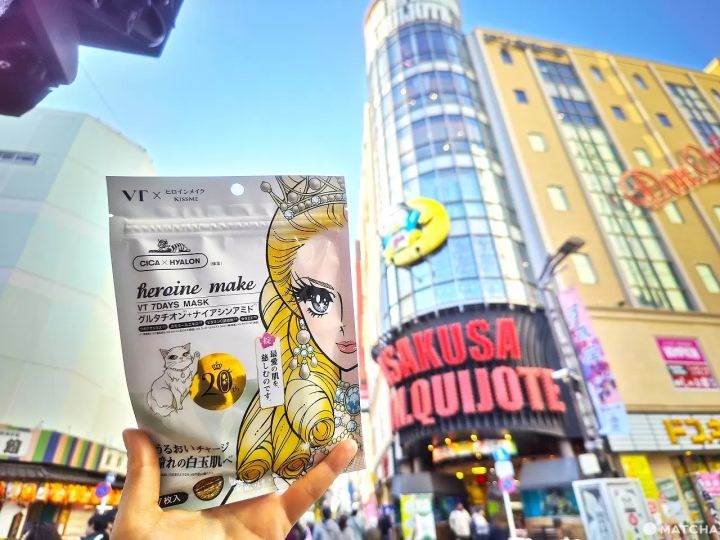

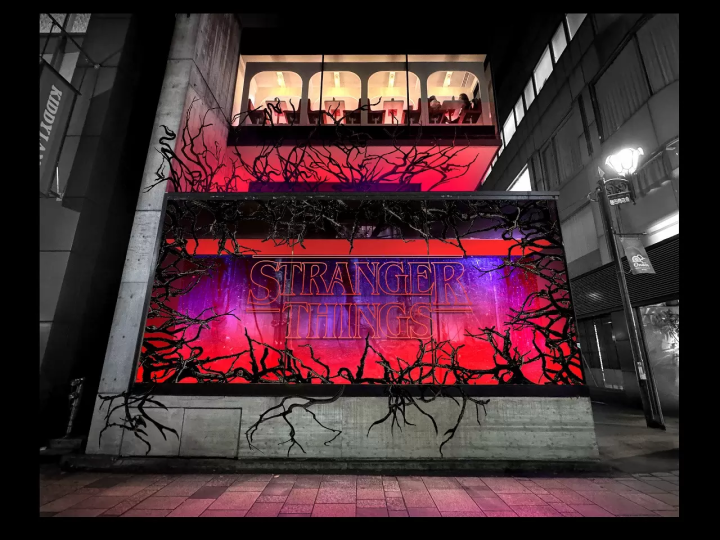
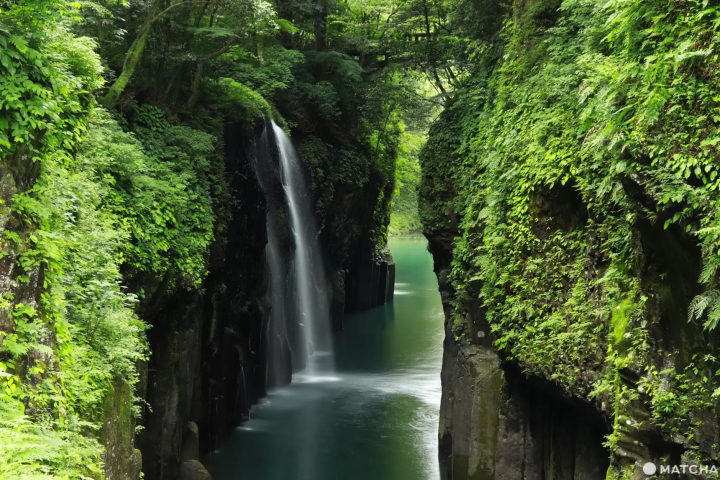




![[Wakayama Sign] Plums and plum wine](https://resources.matcha-jp.com/resize/720x2000/2025/12/08-252248.webp)
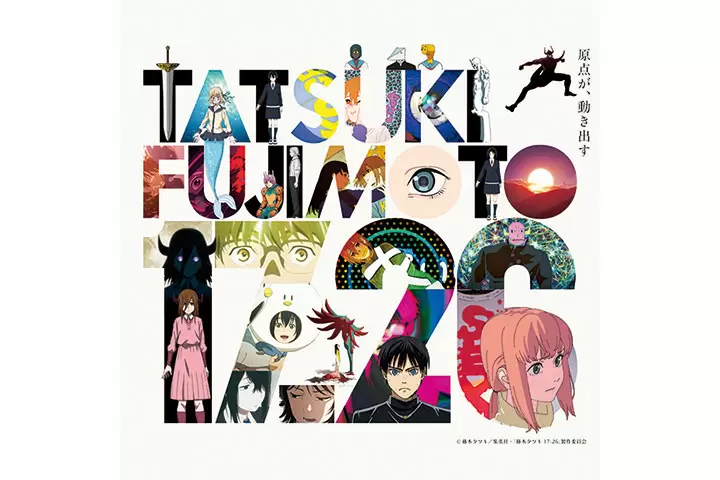
![[2025 Update] Introducing free Wi-Fi spots in Tokoname City , Aichi Prefecture](https://resources.matcha-jp.com/resize/720x2000/2025/12/16-253074.webp)
